As an Amazon Associate I earn from qualifying purchases.
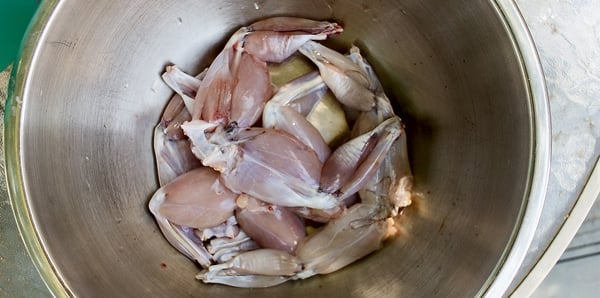
OK, I admit it: This is not the most common skill you will ever need. I mean, how many Americans even eat frog, let alone catch their own — especially outside of the Deep South?
But you should eat more bullfrogs, especially if you live in the West, as I do. Bullfrogs, native to the Southeast, are aggressive, nasty invaders elsewhere. Here in California they are a scourge.
So to do our civic duty Holly, my friend Joel and his wife Mandy headed out to the ponds and marshes around Lake Tahoe. You heard right: Tahoe. At 6,600 feet. This was some high-altitude frog giggin’. You can read more on that, and get my recipe for fried frog’s legs here.
Suffice to say we came home with 14 big bullfrogs. I’d cleaned a frog exactly once before, when I was working in a restaurant in Madison, Wisconsin. I remember it being slimy, but not hard. I was correct.
Most of the meat on a bullfrog is the hind legs — you can eat other parts, but most people don’t. And you don’t want to eat the skin, which is a) loose, b) very slippery and c) really, really strong. So you need to skin and dismember your amphibians.
First, make sure your frogs are actually dead. Being amphibians, they are insanely tough. They will rarely be fully dead when you spear them. They will only be mostly dead. And yes, this is a lot like that scene in The Princess Bride. Whacking them against something hard, like a rock or concrete or the side of your truck, works pretty well. So does stomping them. Sorry, but it’s a tough thing to kill a bullfrog. They don’t die easy.
Once they are all dead, some people drive a nail through a board to impale the frog’s head; this is said to steady the frog while you skin it. I find this step unnecessary. All you need is a cutting board, and a willingness to grab a dead, slimy frog.
You’ll also want kitchen shears, a small, sharp knife, a set of pliers, water to wash the legs, a bowl for the legs and a trashcan nearby.
Start by snipping off the feet. Some people keep the feet on, but I don’t.
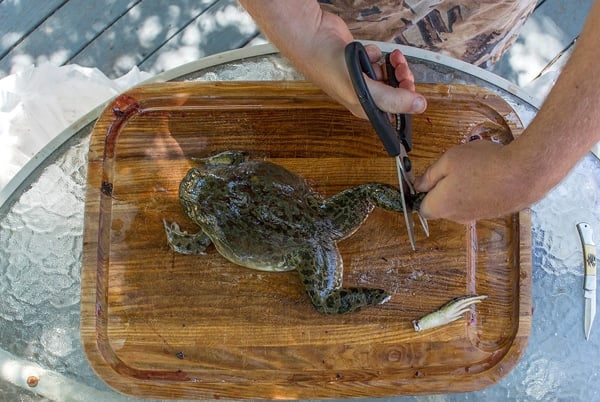
Now on to the only hard part in the whole process: Slicing the skin around the frog’s “waist.” This isn’t really that hard, but the skin is very loose and very tough. I use either the kitchen shears or a knife, depending on my mood.

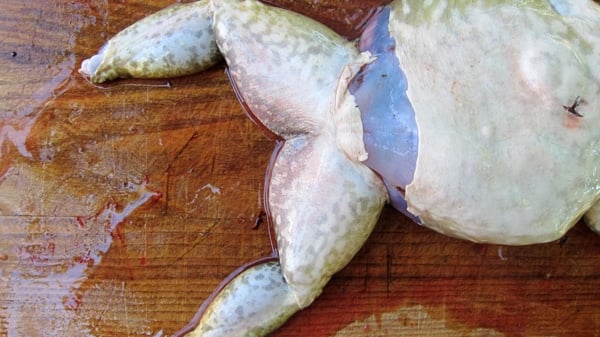
Once you have the skin cut all the way around the frog, the rest is easy. Just take the pliers and grab the loose skin on the frog’s back. Anchor the frog with one hand and yank the skin off with the other. It’s like pulling the frog’s pants down. Ew. I know…
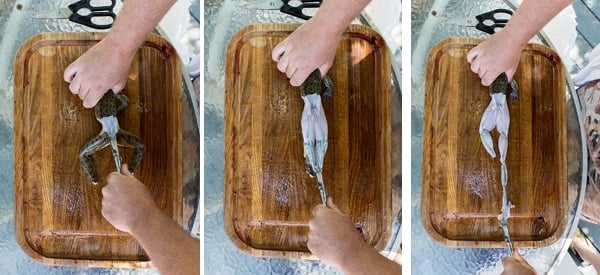
Almost done. Now use the shears to chop the legs off (as a pair) right at the waist.
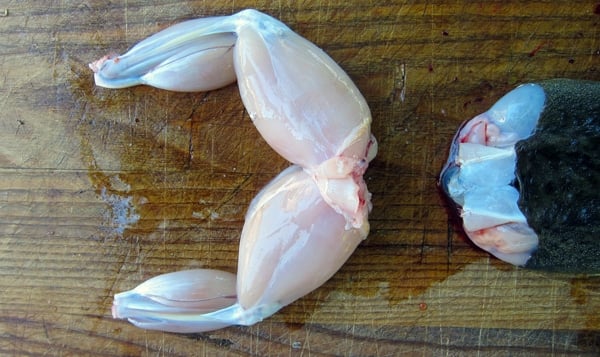
Chop again to separate the legs. I also trim any organ-y looking bits around the middle of the legs. There you have it! Easy-peasy. Once you get the hang of cleaning frogs, you can do one in a minute or so.
When you’re all done, separate the legs into 1 pound bags or so, seal and keep in the fridge for up to 5 days, or freeze for up to a year.




Do you know if legs are safe to eat if you don’t clean them the same night you kill them?
Mcmsavers: Yep, they are, so long as you keep everything cold.
Hank,
Thanks for the instructions. Good information and good advice on harvesting in the West where they aren’t native. We ate frog legs as kids (parents from Mississippi), but I’ve never prepared them. I live in the Sierra foothills and only have one bullfrog – an invader that came in with a water plant and is eating everything in my garden pond. I found two drowned birds and am losing my little goldfish. I hate to kill something edible and not make use of it so I’m giving it a go.
Are California bullfrogs safe to eat?
Angie: Yes, so long as they are not in polluted water. I gig them in Tahoe every now and then
I grew up catching frogs. Back at home in South Europe believe it or not we use a very bright light at night to blind them and they won’t move for a few seconds, grab them by hand and throw them in a bucket. They are delicious
Heard it said freezing amphibians and reptiles is the most humane way to kill ‘em, so The Hub and I now have 3 of the scourge of the Sierra in our freezer. In ziplocks.
Now I’m thinking about those legs. Do you reckon if I thaw them and skin them out, they would still be edible? Or would thawing still attached to the body not be a good plan?
Joy: I bet your plan would work. Skin might come off easier!
Hi, I just read your way of cleaning a frog. I guess there is no wrong way. But I have a way that’s easy and I think a little better. Do like you said killing them. I use a pair of good hunting scissors. I use them to cut the head and feet off. Now I take two finger and work them under the skin on top of the front shoulders and place them behind the front legs, with the other hand I get my catfish skinners and grab the skin by the leg on each leg and pull all the way off with one stroke. Than I use the scissors to cut belly to check plate and degut the frog… Cajun way.. South Louisiana…
Terry: I just recently got myself a pair of catfish pliers. Will have to try that trick, thanks!
I used all of the frog the hind legs I fried I cleaned the rest of the frog and I make a roux to make a stew or a soup
Louie: Great idea!
I’ve not been there (yet) but I have it on good authority that Lake Tahoe also supports a healthy population of crawfish.
I read freezing a frog makes lose its flavor. I read that in Jase Robertson book good call and he’s been catching cooking and eating frog legs for a long time
Steve: Frozen frog legs are better than no frog legs.
Break there neck as you catch them by incerting your index finger in there mouth your thumb on the back of there head and break the neck.
Do you reccomend soaking the frog legs in salt water prior to cooking and/or freezing?
Paul: Not especially, but you can if you want.
“Make sure your frogs are dead”. Hahaha, I recommend using the nail through the head method, especially if you use a cane pole and fly to catch them. After smacking their heads against my bench 3, 4, 5 times to kill them, I cleaned them (robbed them of their legs) and tossed the carcasses in a bucket to bury in the garden as fertilizer. It was getting late so I figured I would bury them in the AM. Boy, was I surprised when I looked in that bucket the next day. EVERY ONE of those 30 or so frogs was a lookin’ back at me! Needless to say, it was a little disturbing realizing the extra suffering I caused. Do the frogs a favor, use a nail!
A frozen five pound box in Memphis is about $19 which is pretty cheap compared to buying from a restaurant,and I love cooking them my self.
Forgot to update. The frogs tasted like strong chicken. They are cheap in Bangkok, but not cheap enough for the amount of meat. Still, fun experience!
I am about to prepare some previously frozen frogs I bought here in Bangkok. Wish me luck! I’ll update when I’m done.
Who needs a spear when u got a hand and another guy waving a flashlight around
Beautiful bowl of bullfrog at Chinatown, Singapore… Not sure of the toxins in the skin… But it sent me uforic for a day or two and still shaking… Meat beautiful but watch the skin
I ate tons of frogs legs as a Boy Scout. We’d canoe through the swamp at camp, one guy doing the paddling, the other in the bow, smacking frogs on the head with the flat of a paddle, and tossing them in the boat.
Back to camp, we’d skin the legs (later on in life, we young men would learn that panty hose and frog skin unravel about the same way…), and pan fry them
Best way is garlic, rosemary, oil and Parmesan then baked
Over the years we have prepared frogs in many different ways, but we have posted some of our family favorites on our website. Please follow the link below and we hope that you and your family enjoy them as much as we have.
https://frog-gigging.com/Recipes.aspx